by His Holiness Satsvarupa dasa Gosvami
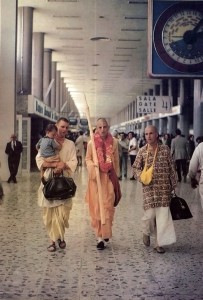
Haihaya dasa, the President of the Mexico City Hare Krishna center, invited me to come speak to the people of Mexico at the installation festival for their center’s Deities of Radha and Krishna. At the time I was in Dallas, Texas, and so was Muralivadana dasa, an ISKCON Press traveling photographer. Taking the invitation as a transcendental opportunity, we decided to fly together to Mexico City, hopeful that through writing and pictures we could share our experience with Back to Godhead readers.
Of course, Mexico City is actually just another illusion. The world is filled with many famous countries and cities advertised as adventures or paradises to lure world travelers. But we can understand, seeing things through the eyes of the Vedic scriptures, that this whole material world exists only as a dream and only because of our attachment to it.
In the commentary to his Srimad-Bhagavatam translation, His Divine Grace A.C. Bhaktivedanta Swami Prabhupada writes: “The great ocean of material nature is tossing with the waves of time, and the so-called living conditions are something like foaming bubbles that appear before us as bodily self, wife, children, society, countrymen, etc.” In other words, not only our bodies but also our nations and our entire planet itself exist only for a period of time that is relatively short when viewed from eternity. The living soul is actually different from matter, but because of our lack of knowledge of the self and the Supreme Spirit, the force of ignorance victimizes us, spoiling the valuable energy of our human life.
We are searching after permanent living conditions that are not possible in this material world. However the idea of traveling to a foreign land like Mexico exhilarates us, such havens are all within the kingdom of illusion, known in Sanskrit as maya. Not only is life in the material world temporary, but it is full of misery for all. Whether in Mexico speaking Spanish, in France speaking French, or wherever one may be, everyone in the material world must suffer birth, death, disease and old age. Therefore whether we travel or sit in one place the real purpose of human life is to seek enlightenment from the illusion and pain of identifying with the material world.
We should be interested in Mexico, therefore, only in terms of the enlightenment of the people there. For example, Krishna spoke His sublime philosophy in the scripture Bhagavad-gita at a place known as Kuruksetra. Now, transcendental scholars and devotees of Krishna are interested not only in Krishna but also in Kuruksetra, the place where He spoke; but they are interested in Kuruksetra only because of its relation to Krishna and the enlightenment He gave there.
The idea of finding permanent happiness by going to Mexico (or France, Hawaii, or India) is actually illusion. But on the other hand, even though any place in this material world is a place of illusion, every place is also the property of God, for everything that exists, whether material or spiritual, belongs to God. One who sees things as they are is interested in everything in terms of its relation to God. He does not reject anything, if one can revive his God consciousness, this will dispell all illusion, and then for him any place, even within the material world, will be fully spiritual, like the eternal, blissful kingdom of God. The center for Krishna consciousness in Mexico City is attempting to free the whole city from the false idea that the body is the self and help everyone regain his original eternal place in the spiritual sky.
During the plane trip we met a young Mexican boy named Octavio who was traveling with his family. He spoke English and was very interested in what we had to say about Krishna consciousness. He took some spiritual food (prasada) that we offered and was very open and friendly. His mother would ask him questions about Krishna in Spanish, and he asked us in English. Very agreeable to the concept of being vegetarian, he remarked, “Yes, you do not like to kill animals!” Our first meeting with a Mexican encouraged us. We noticed that at least one family found it enlivening to speak to devotees, and we were also very pleased to speak with them.
Thinking in this way about our trip to Mexico as a transcendental opportunity, we flew down through the clouds past large mountain ranges and descended upon Mexico City, a sprawling metropolis of ten million people.
After the plane landed, we kept chanting the Hare Krishna mantra on our beads, not knowing what to expect of Mexico City. As we approached the officials for immigration and customs, one airport worker waved his hand and greeted us loudly, “Hare Krishna!” Soon we passed through a large crowd of incoming passengers and met our God-brothers Haihaya and Bahulasva. In the truck riding to town, Haihaya told us that at least one hundred Mexicans regularly attended the temple’s activities day and night and at least another fifty boys and girls were full-time devotees.
About a year ago, His Divine Grace A.C. Bhaktivedanta Swami Prabhupada visited the Mexico temple and stayed for five days. Haihaya explained that Srila Prabhupada was widely acclaimed, just on sight as a great saint; although some of the people were not even aware of the Vedic philosophy, they still recognized him as a very saintly person. And many of them went to see him, eager to receive benediction from Srila Prabhupada.
I asked Haihaya about the claim that the ancient Mayan culture that existed thousands of years ago in Mexico was imported from the Vedic civilization of India. When Srila Prabhupada was there, Haihaya said, he stated that there was much in Mexico reminiscent of the Vedic culture. One who lives there can see this in the people’s eating, parades, natural fruits, etc. There is also much archaeological evidence such as art work in temples, and archaeologists can more seriously study this for further evidence.
When Srila Prabhupada was in Mexico he primarily stressed the importance of enlightening people about their spiritual nature by distributing Krishna conscious literature in Spanish. I asked Haihaya whether the people of Mexico City were taking Krishna consciousness seriously. He replied, “Many of them come with beads and chant Hare Krishna just like full-time devotees. After they buy books, they always read them and ask for more. Also, many of them take to a vegetarian diet after hearing our philosophy.”
It was not long before we arrived at the temple, which is on Governador Tiburcio Montiel, just two blocks away from the house of the nation’s President. We drove through a decorated iron gateway into the yard of the Hare Krishna temple, a three-story white building with domes on the roof that looked Vedic. There was a large lawn in the courtyard, where many guests were sitting under trees. There were also many devotional activities underway, such as sewing, preparing flowers, building, painting and washing.
As we entered the yard a chanting party started singing Hare Krishna, Hare Krishna, Krishna Krishna, Hare Hare/ Hare Rama, Hare Rama, Rama Rama, Hare Hare. The chanting of Hare Krishna washes away all material designations by which one thinks his real self to be Mexican, American, black or white. One feels his happy, pure identity as a spirit soul, servant of God, by chanting this mantra. We felt immediately that we were in our true home, the shelter of Krishna, and joined with everyone who was singing and dancing. Afterwards, we were offered flower garlands and a dish of fruit prasada. According to Vedic hospitality, whenever a guest comes to visit, one must offer him nice things to make him feel at home. Any local culture in the world can adopt this philosophy and way of life, in any language, and it always comes out pure and natural.
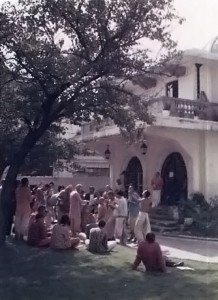 This way to live in transcendental life (bhakti-yoga) is natural because it applies everywhere. Therefore Srila Prabhupada, as a devotee of Krishna in disciplic succession, has had great success in establishing Krishna conscious centers as oases of relief in the midst of the materialistic cities. In the mood of a humble Vaisnava, our spiritual master never claims credit for his achievements of opening over one hundred centers all over the world; he says the credit goes to the Lord Himself and the previous spiritual masters, whose instructions he has followed without deviation. Nevertheless, because of his personal instructions, once again we saw a living community of men and women, this time in a culture foreign to us, who were peaceful and happy in the execution of devotional activities.
This way to live in transcendental life (bhakti-yoga) is natural because it applies everywhere. Therefore Srila Prabhupada, as a devotee of Krishna in disciplic succession, has had great success in establishing Krishna conscious centers as oases of relief in the midst of the materialistic cities. In the mood of a humble Vaisnava, our spiritual master never claims credit for his achievements of opening over one hundred centers all over the world; he says the credit goes to the Lord Himself and the previous spiritual masters, whose instructions he has followed without deviation. Nevertheless, because of his personal instructions, once again we saw a living community of men and women, this time in a culture foreign to us, who were peaceful and happy in the execution of devotional activities.
Since the next day was to be the festival and installation of the forms of Radha and Krishna, many devotees and guests were involved with projects of sewing, painting, electrical work and cleaning, and were also talking about Krishna. The temple building opens with a large hall with a winding staircase that dramatically sweeps up to the second floor, which is actually a balcony with rooms off it. The main hall can accommodate hundreds of guests for chanting and feasting, the main activities of bhakti-yoga.
Eager to show us the forms of the Supreme Lord Krishna and His eternal consort, Radharani, Haihaya took us to a private room where devotees were sewing dresses for the Deities. He uncovered the forms of Radha and Krishna, and we bowed down and paid our obeisances. Krishna is a young boy holding a flute, and Radharani is a young girl. Atheists deny the existence of any spiritual form or spiritual life, and even beginners in transcendental life do not understand that the Supreme Spirit is the Supreme Person. But this is the conclusion of the most authorized and complete philosophy of God consciousness. The Absolute Truth from which all varieties of life, both temporary and eternal, emanate is the supremely conscious Supreme Person, Krishna. All His forms, incarnations and emanations are originally present in His transcendental form.
The Vedic literatures describe that Krishna actually appeared on this planet as a cowherd boy five thousand years ago. As described in Bhagavad-gita and Srimad-Bhagavatam, although He appears in human society to rescue souls who have fallen into the ignorance of material life, He never comes under the material laws nor accepts a material body.
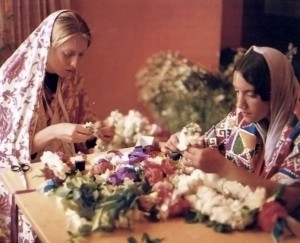
Krishna says in Bhagavad-gita that although He is unborn and His transcendental body never decays, He nevertheless appears in this world in every age. In our present state we cannot see the spiritual form of Krishna, which is eternal bliss and knowledge, yet out of His mercy He appears in the incarnation of the Deity, which may be a form of metal, stone or wood. The worshipers of Krishna do not worship wood or stone, but they worship Krishna in this form, which is visible even when one has conditioned, material vision. The exchange between the Lord and the devotees in the Deity worship is fully authorized, and one should scientifically understand it by reading ISKCON books such as The Nectar of Devotion, which discuss thoroughly this transcendental science. It is a scientific transcendental fact that the Lord appears in the form of a Deity just to accept food and decorations offered in the clean and spiritual atmosphere of the temple.
On the evening before the festival day, about one hundred guests gathered. Haihaya kindly allowed me to lead a class in Bhagavad-gita. After reading from the Gita first in Sanskrit, I spoke in English, and a bi-lingual devotee immediately translated my words. Seated on the temple floor, devotees and guests listened with obvious attention and absorption to the words of Bhagavad-gita. I read from the Twelfth Chapter, where, in the first verses, Arjuna asks Krishna, “Upon which is it more perfect to meditate-the impersonal or the personal form?” Krishna then clearly says that whoever worships His personal form is the most perfect. The temple is also stated to be the ideal place for such perfect worship of God.
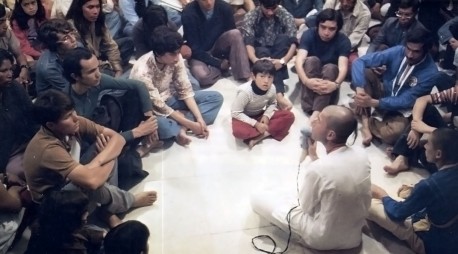
Of course, God is not present only in a Hare Krishna temple; He is all-pervading. But it is recommended that while one should increase his taste for singing and chanting the glories of the Lord, he should also increase his inclination to live in a place where Krishna lives. Krishna certainly lives everywhere. This is the vision of the highest devotees. But because we are in a lower condition, still attached to material life, and we cannot see Krishna everywhere, we should learn to see Krishna in the temple. It is stated in Srimad-Bhagavatam that especially for worldly householders it is necessary to come to the temple to enjoy musical kirtana, worship the form of the Lord and appreciate the spiritual atmosphere. This is the only thing that will save the common man from hellish movies, naked nightclub dancing and other materialistic endeavors. Everyone is encouraged to dovetail his propensity for social gatherings, festivals and singing by taking part in glorifying Krishna, the Absolute Truth; otherwise one will waste his life and have to go down in the next life to some lower form of life, seeking pleasure in dead material things. And in every form of material life from king to insect there is always suffering.
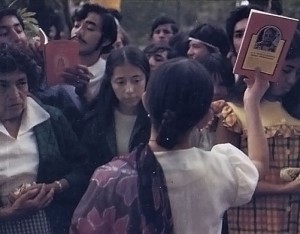
By speaking Bhagavad-gita and answering the questions of the assembled devotees, I could understand that the Mexicans were accepting Krishna consciousness in a nonsectarian spirit. Haihaya explained to me later that attraction for Krishna is very great in Mexico because the people are looking very seriously for God, although they often regard their past religious education as frustrating. Many of them see the Krishna consciousness movement as the answer to their search. The devotees are very respected in the streets, and people very often inquire about the philosophy. People respect the movement more and more as they hear more about it.
As phrase by phrase of my English was translated into Spanish, I tried to remember exactly the words of my spiritual master: “We should be inclined to live in the circle of temple life and increase our inclination to chant more and more. If at the time of death we can think of Krishna, then we can go and associate with Him eternally in His spiritual abode.” Young boys and girls, respectable ladies and gentlemen, old men and women-all listened with great respect. They were mostly regulars who come daily to the temple to worship the Deity and take spiritual food. Now they could understand that with the appearance of Radha and Krishna the temple activity would be more blissful and there would be more opportunity to elevate their consciousness higher and higher in love of God.
After the class we had another kirtana, chanting the names of God. In this congregational chanting the Mexican temple is practically unexcelled in the world. Accompanied with the traditional Vedic mrdanga drum and karatalas, as well as congo drums and guitars, the singing was full of enthusiasm and pleasure. A small group of singers and musicians gathered in the center, leading the chanting, while others danced around in a circle, chanting these universal names of the Lord-Hare Krishna, Hare Krishna, Krishna Krishna, Hare Hare/ Hare Rama, Hare Rama, Rama Rama, Hare Hare. Sometimes the lead singer would switch to other chants, chanting the name of the spiritual master, “Srila Prabhupada! Srila Prabhupada! Srila Prabhupada!” or chanting “govinda jaya jaya” or the names of the Lord’s merciful incarnation Lord Caitanya-sri-Krishna-caitanya prabhu nityananda sri-advaita gadadhara srivasadi-gaura-bhakta-vrnda-and then back again to the Hare Krishna mantra. This chanting went on literally hour after hour without stopping. No one became tired; the enthusiasm increased more and more until it was ten o’clock and the temple managers had to end the kirtana. This chanting goes on every evening, and it is always a great success.
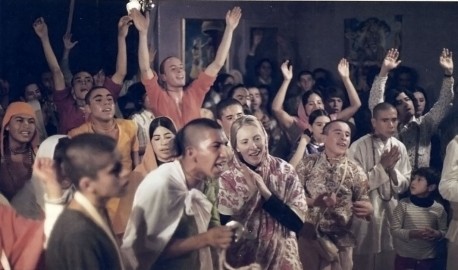
The next morning everyone rose an hour and a half before sunrise, which the Vedic civilization recognizes as the best time for spiritual advancement. After the early-morning gathering for chanting in the temple, everyone turned to the last preparations before the installation of the Deities, putting last-minute light fixtures in place and painting and sewing for the Deities. There was no distinction between devotees and guests; everyone was busily serving, sweeping, mopping, cooking, decorating and so on. Some devotees had been up all night cooking a feast and cleaning. Everyone engaged his senses in some kind of preparation to please the Lord. Haihaya dasa’s greatest aspiration is to engage everyone, old and young, in some kind of work for Krishna.
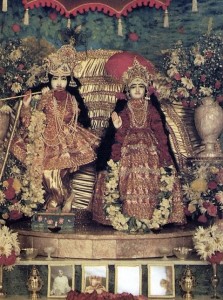
The time for the beginning of the ceremony finally arrived, and simultaneously all preparation was completed. The procedure for installing the Deities in a bona fide Krishna conscious temple is to bathe Them in milk, yogurt and water while reciting the devotional prayers of the Brahma-samhita and then to hold a fire ceremony in which grains and ghee (clarified butter) are offered in the fire while more mantras are chanted. The first verse of the prayers of Lord Brahma’s Brahma-samhita are as follows: “I worship Govinda, the primeval Lord, the first progenitor, who is tending the cows, yielding all desire, in abodes built with spiritual gems, surrounded by millions of purpose trees, always served with great reverence and affection by hundreds and thousands of goddesses of fortune.”
During the installation of the Deities, the priest leading the ceremony is supposed to speak about the worship of the Deity. I spoke on a chapter I had read from Srila Prabhupada’s Krishna Book. In the chapter “Prayers by the Demigods for Lord Krishna” there are 5,000-year-old prayers offered by demigods who knew that the Supreme Personality of Godhead, Krishna, was about to descend to the material world to vanquish the demons and give pleasure to His devotees.
Different classes of people speculate about God. Atheists say there is no God, and some transcendentalists say God is void, impersonal or formless because they cannot grasp the idea of a spiritual form. Sometimes yogis realize God as the form of Visnu in the heart, which they see in trance. But according to the Vedic literatures all these aspects of the Absolute Truth are included in the highest realization, which is called Bhagavan realization of the Personality of Godhead in His original spiritual form as Krishna.
The demigods described that when Krishna actually appears in the world He puts an end to all imaginative iconography about what God is. Some philosophers speculate that because God is the oldest person, He must be an old man with a beard. According to the Brahma-samhita prayers chanted during the Deity installation, however, although He is the oldest, Krishna appears as a fresh youth. He has a light blue hue, and He appears like a young boy, never older than sixteen, a cowherd boy who always plays His flute. This is the same form of Krishna described in the Vedic literature, as He actually appeared five thousand years ago and as He appears in the Deity form.
In a court case discussing whether a certain man is alive or dead, there will be various speculative opinions. But if the man being discussed actually walks into the courtroom, upon his appearance all speculation vanishes. In the same way, Krishna, the Supreme Personality of Godhead, demonstrated clearly by His appearance what He is really like. The whole disciplic succession of great spiritual masters and all the great authorities of the Vedas accept Krishna as the Supreme Truth. Krishna says Himself in Bhagavad-gita that whoever considers Him an ordinary material person is “mudha,” which means a rascal or ass.

We are all originally eternal servants of Krishna. But, because of our dirty desires, we have left His service and are now trying to act like the Lord ourselves. To help us back to our original position, Krishna comes Himself or sometimes sends His incarnation, son, representative or pure devotee-and He also appears in material forms such as stone or metal as the Deity. In such forms He accepts offerings of food and decorations, provided such offerings are made in loving devotion. Devotees who worship Him in this form are not performing idol worship, but are worshiping Krishna in an authorized manner. Although He is very difficult to understand, He comes before us as the sound of His holy name, as the words of Bhagavad-gita, as prasada (spiritual food) and as the Deity, and none of these forms are material. Krishna has so kindly made Himself available. Therefore, we can clearly comprehend why the Lord declares that whoever doesn’t accept Him as He is but thinks Him an ordinary person of the material world is “mudha,” a rascal.
The devotees in Mexico City had taken great pains to decorate their temple. They had painted all the walls to look like Vrndavana, the forest setting where Krishna plays in the spiritual world. The vyasasana, or seat of the spiritual master, was very nicely situated also, just awaiting the arrival of Srila Prabhupada. The picture of Srila Prabhupada was placed on the seat, reminding devotees of his presence. Near Mexico City a pure marble stone called onyx is abundantly available, and the devotees had arranged an onyx altar with onyx dishes and cups for offerings to the Deity. Their Lordships were dressed very beautifully with golden garments. Everyone was chanting and dancing in appreciation of Their Lordships, and the chanting went on for hours. Then there was feasting. On the front lawn under a big tree in the shade, I sat with Haihaya and met various friends of the temple.
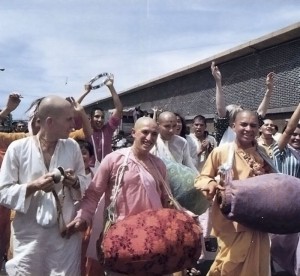
As far as the mundane Mexico City is concerned, we could see that it is geared, like the United States, towards material goals. The worker is very much pressured to work to increase his pay and enjoy sensual life. Everywhere billboards promise: “Come, you’ll be happy if you buy this beer.” “Buy these pants and you’ll be satisfied.” Cars rush back and forth, and on the way to the temple from the airport we had seen several accidents within a few hours. But while the illusory struggle for pleasure went on in the material world of Mexico City, a hundred or so people gathered in the courtyard of the Krishna Temple, enjoying real life. Every day in the Krishna Temple there is not only feasting but hard work, but it is all done for Krishna, for it is the philosophy of Krishna consciousness that one should stay in his position as a householder, businessman or whatever and yet perfect his life simply by chanting and hearing Hare Krishna and offering food to Krishna.
After chanting and feasting for some time, a large party gathered to chant downtown. We drove to various spots and chanted the holy names. Large crowds gathered, and we profusely distributed Spanish translations of Vedic literature.
As the afternoon progressed, we noted regretfully that we had to return to our duties in the United States. As Muralivadana and I finally left our Godbrothers to head for the plane, we both felt we had visited the real Mexico, not the illusory Mexico known to most travelers. The permanent, pure essence of human consciousness is to practice love of God in a society of peace, prosperity and loving relationships. Everyone desires this universal brotherhood, but the different “isms” that have been formed are not satisfying because their center is not universal. Because Krishna is the Absolute Truth and source of all emanations, the Krishna consciousness movement has a universal center and can be universally auspicious for all.
It is not a sectarian idea. Our visit to another nation convinced us by experience that Krishna consciousness can successfully adapt to any mundane culture and “Krishna-ize” it. Just as an iron rod in a fire gets hotter and hotter and finally acts as fire, so anyone or any place becomes pure by association with Krishna consciousness. One can practice this perfect life anywhere by following the Vedic scriptures under the direction of an expert spiritual master. As long as there are sincere souls, they will gather to hear the message of Krishna consciousness and purify their lives.


Leave a Reply